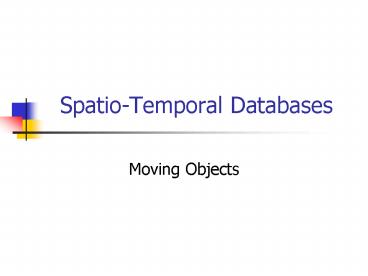Spatio-Temporal Databases - PowerPoint PPT Presentation
1 / 22
Title:
Spatio-Temporal Databases
Description:
Database stores the current location of each object and the ... Simonas Saltenis, Christian S. Jensen, Scott T. Leutenegger, Mario A. Lopez: Indexing the ... – PowerPoint PPT presentation
Number of Views:112
Avg rating:3.0/5.0
Title: Spatio-Temporal Databases
1
Spatio-Temporal Databases
- Moving Objects
2
Introduction
- Spatiotemporal Databases manage spatial data
whose geometry changes over time - Geometry position and/or extent
- Global change data climate or land cover changes
- Transportation cars, airplanes
- Animated movies/video DBs
3
Spatio-temporal Queries
- Historical Queries Store the past the history of
a spatio-temporal evolution. - R-tree, MV3R-tree (PPR-tree)
- Future Queries Find the future positions of
moving objects. - Indexing?
4
Indexing moving objects
- Database stores the current location of each
object and the velocity vector. - Example cars moving in a highway system. GPS
can provide position/velocity
5
Moving Objects Queries
- Range Queries
- NN queries
- Aggregation queries
Q
6
Moving ObjectsRepresentation
- Consider the 1-d case (objects moving on a line)
- Storing the locations of moving objects is a
challenge - Update the database with the new locations
- Use a function of time f(t) to store a location
- Update overhead is reduced update the database
only when velocity changes
7
Space-time
- Trajectories are plotted as lines in the
time-location space (y, t) p(t) vta
trajectories
o
1
o
2
o
3
o
4
(t) time
8
Indexing
- Use R-tree to index the lines? Large MBRs,
extensive overlap - Use a Quadtree approach (or a grid)
- Partition the space into cells, store for each
cell the lines that intersect it - Disk space is increased
9
Dual space-time
- Idea map a line to a point
(y) location
intercept
trajectories
o
o
1
1
o
2
o
3
o
4
o
2
o
3
(t) time
slope
intercept
10
Dual space-time indexing
- Query must be transformed. (y1q, y2q), (t1q,
t2q) - a t2qv gt y1q and a t1q v lt y2q , for vgt0
- a t1qv gt y1q and a t2q v lt y2q , for vlt0
11
Dual space-time indexing
- Another transformation (Hough-Y) is
- The difference is that we compute the intercept
over a horizontal line - Queries in the dual space are similar with the
previous transformation
12
Hough-Y space
13
Querying the dual space
- Use a PAM to index the dual points, change the
search function to find the points inside the
query - Problem Partitioning is not aligned with the
queries ? many I/Os - An idea is to try to store multiple structures,
one for each set of queries with similar slope
14
Improving the query
- In the Hough-Y, the slope of the queries is y1q
yr (or y2q yr)
location
y3
y2
query
y1
time
15
Improving the query
- Compute the dual using multiple y-lines
- Store an R-tree for each line
- Given a query, find the line that is closer to
the query and then use the corresponding index - Thus, the query will appear as vertical as
possible ? better performance
16
Indexing in 2-dimensions
- The dual transformation can be extended to 2
dimensional points - Map the trajectories in a point in 4-d using the
transformations on x-t and y-t planes - Use the 1-d structures to answer a query
17
Dual for 2-D Moving Objects
- Using Hough-X
- Map a moving point p with location (px, py) and
velocity (vx, vy) to the 4D point (vx, ax, vy,
ay) - Query is also transformed to a linear constraint
query - Q(x1q, x2q), (y1q, y2q), (t1q, t2q)
- ax t2qvx gt x1q and ax t1q vx lt x2q
- ay t2qvy gt y1q and ay t1q vy lt y2q
- x1qvy - y2qvx lt axvy ayvxlt x2qvy - y1q vx
18
TP R-tree
- Time-Parametrized R-tree
- Store the MBRs as functions of time
- The MBRs grow with time, at any time instant in
the future we can compute the MBR
19
Motion function
- For each object, the database stores
- Its minimum bounding rectangle (MBR) at the
reference time 0 - Its current velocity bounding rectangle (VBR)
- Examples MBR(a)2,4,3,4, VBR(a)1,1,1,1
MBR(c)8,9,8,9 - An update is necessary only when an objects VBR
changes.
20
TPR MBRs
21
Insertion and Deletion
- Insertion and Deletion similar to R-tree
- The only difference is that you have to compute
the values margin, overlap, volume over time - Trick try to optimize the structure for the next
H time instants. - Another optimization when you update an object,
re-compute the MBR at the current time
22
y
o1
o2
o3
o4
t
update
time
An example of update and re-computation of MBR
(1D)
Reference Simonas Saltenis, Christian S. Jensen,
Scott T. Leutenegger, Mario A. Lopez Indexing
the Positions of Continuously Moving Objects.
SIGMOD Conference 2000 331-342































